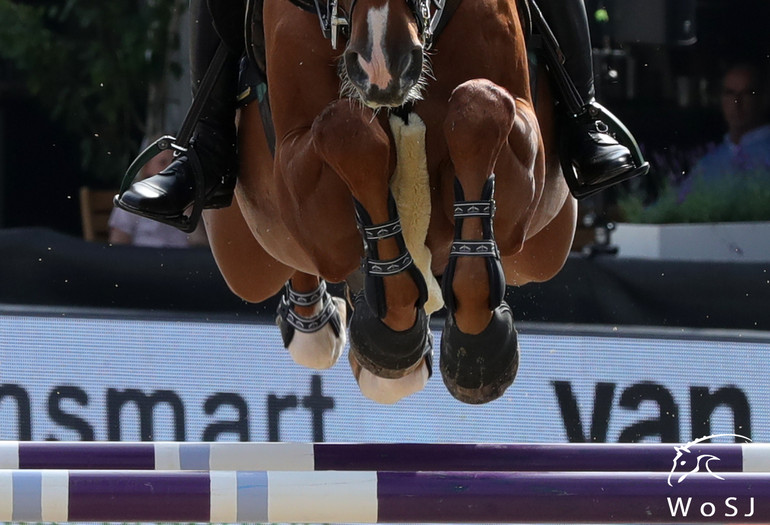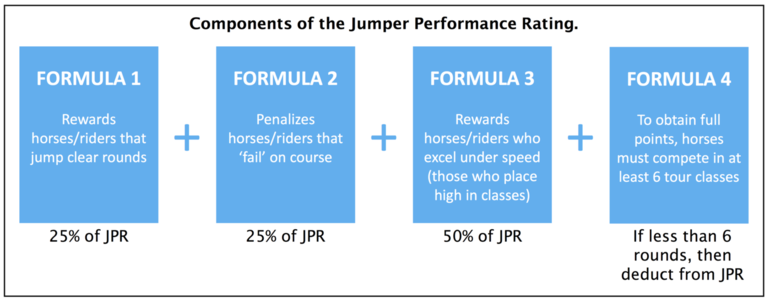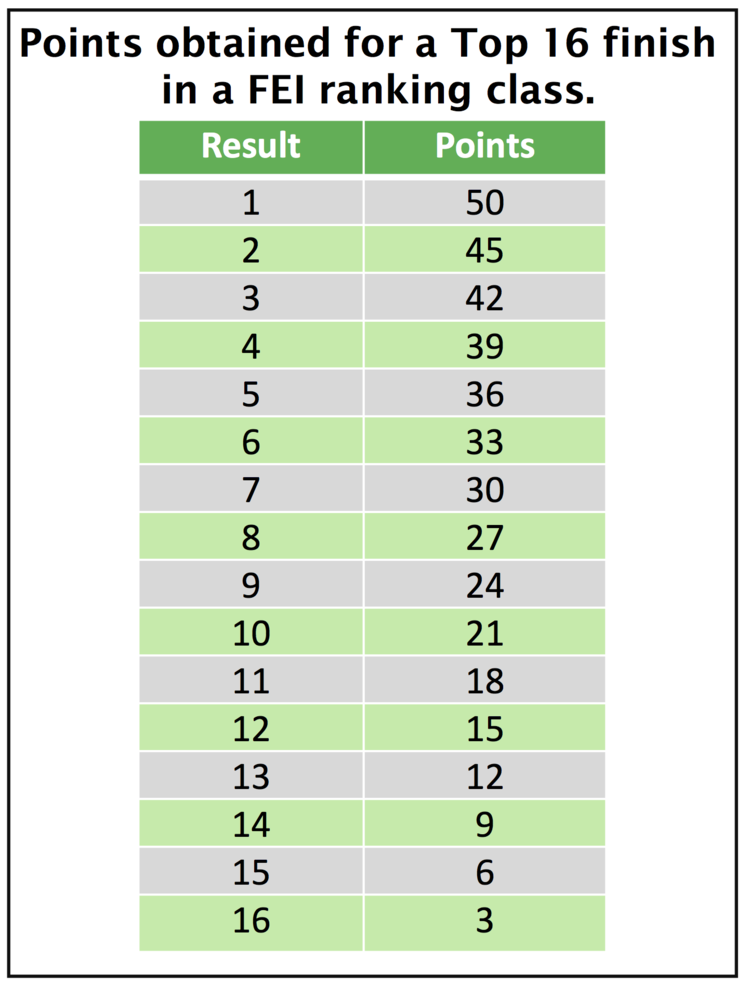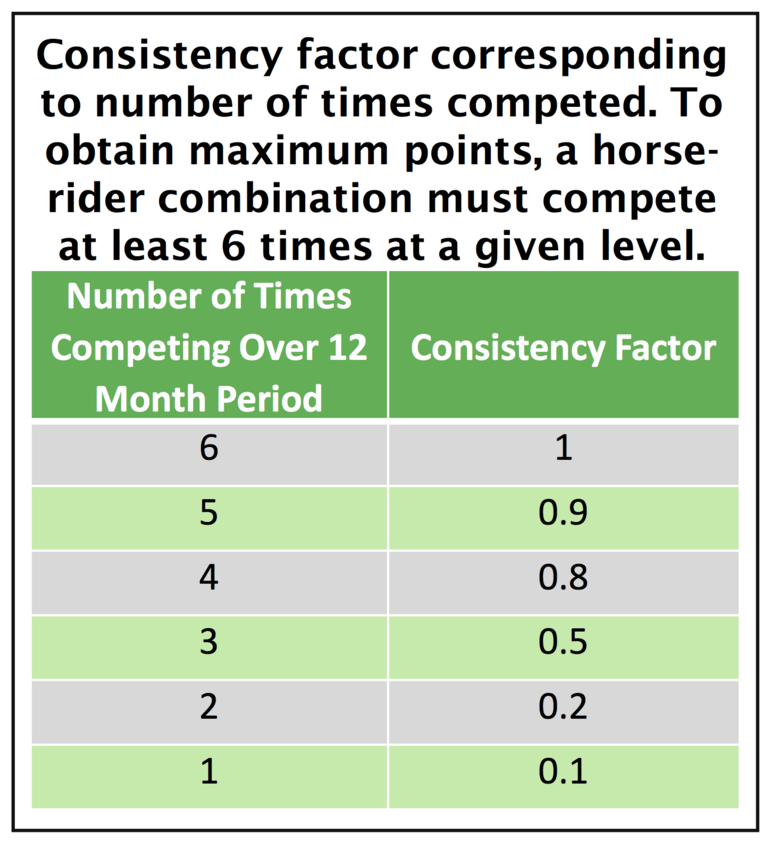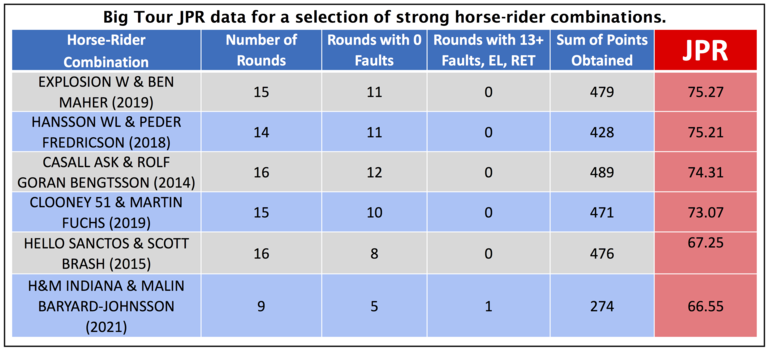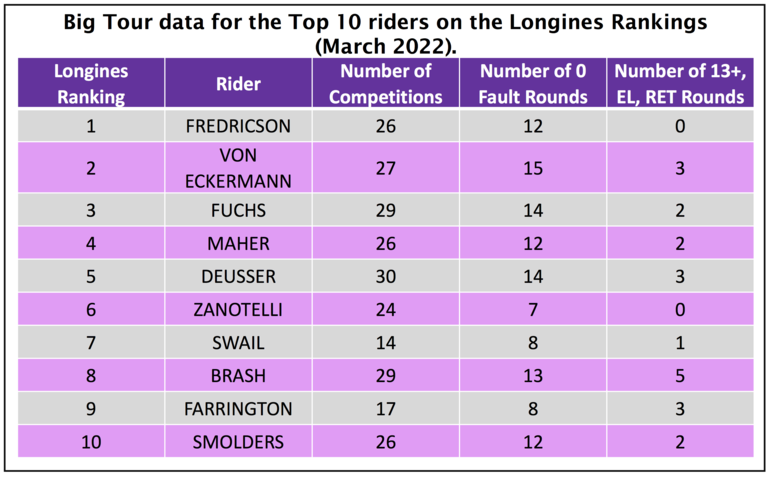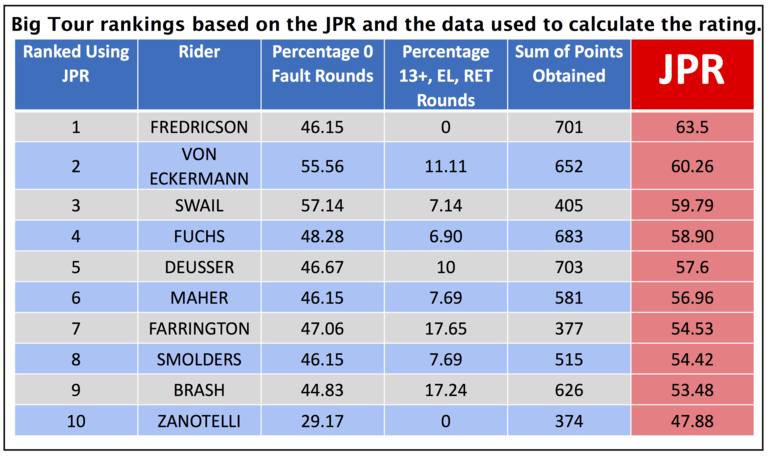by Tim Worden, PhD
About the author:
Dr. Tim Worden is a Canadian sports scientist who has worked with numerous FEI-level show jumping riders. He has a PhD in biomechanics and specializes in applying high-performance training techniques to horses. He is also a member of the Equine High-Performance Sports Group, Sport Horse Research Foundation, and is Business Operations Manager for Inteligex – a biotechnology company developing stem cell therapies for nervous system injury.
Show jumping has evolved rapidly over the past decade and, in my opinion, requires new methods to assess performance beyond what the current Longines Rankings provide. There is an opportunity to adopt a new system that better reports who the best riders and horses are in competition, while also creating new narratives that will serve to select riders for teams and enhance interest in the sport.
I have been fortunate to have had discussions with numerous stakeholders in human-centric sports over the years, and the one theme that consistently shines through is the importance that data plays in modern sports. On the performance and injury prevention side, it is widely accepted that incorporating analytics into sports leads to better performances and reduced injuries.
In jumping, there is a major void in the analytics used
On the business side, data displayed during television broadcasts and through other media platforms is known to increase viewership, which in turn drives increased sponsorships and revenue. Providing fans with data-driven insights that go beyond simply discussing wins and loses creates interest, and when properly framed by knowledgeable media personalities, can allow a sport to grow and engage a wider audience.
In jumping, there is a major void in the analytics used. Essentially the only metric readily available to fans is the Longines Rankings, but this measure has a number of limitations and is poorly predictive of success in most circumstances. In my opinion, a world ranking system should be strongly predictive of who will perform well at major competitions.
Check out the graphic below. It lists the individual medalists for the last five major championships and their world rankings at the time they podiumed.
In most sports, the top ranked athletes in the world typically do well in major championships. However, in the last five international championships, no rider ranked in the top 5 in the world at the time of competition has obtained an individual medal. This highlights that the Longines Rankings are the wrong measure to use when discussing a rider’s potential to perform well on a given day. And since casual fans are not following smaller classes during the week, but instead tune in to just watch the grand prix broadcast, this represents a tremendous opportunity to create a ranking that will be informative and predictive of performance.
Currently, the Longines Rankings are the main metric used in our sport to rank the best riders in the world. To read how the Longines Rankings are calculated, click here.
Essentially, the top ranked rider in the world is whoever can collect the 30 best results over a period of 12 consecutive months. A rider can show an infinite number of horses and an infinite number of times, but only the top 30 placings in ranking classes contribute to points – all other results have no impact.
On a given day, the Longines Rankings are a poor metric for a casual jumping fan to be exposed to
So, what do the Longines Rankings tell us? It indicates that top ranked riders have access to multiple quality horses and are able to manage the horses well, typically compete often, can successfully ride different horses, and consistently get invited to compete at the biggest shows. It is important to note that top-level shows offer the most prize money, which in turn means the most ranking points. Since invitations to compete at the top shows are determined by Longines Rankings points, there is a cycle of the top-ranked riders always having access to the best shows for acquiring more points. Conversely, lower ranked riders with talented horses are blocked from competing in big shows, which in turn keeps them stuck lower on the Longines Rankings where they are unable to access the shows needed to advance.
But on a given day, the Longines Rankings are a poor metric for a casual jumping fan to be exposed to. Sport fans want to know who the best athletes are and who is most likely to put in a good performance in the class they are viewing.
Why do the Longines Rankings fail to accurately report the best in the world?
1) For any major class, it is one horse-rider combination competing and that is how they should be discussed. It doesn’t make sense to talk about a rider’s Longines Rankings when they are collecting points on ten different horses (i.e. only 10% of a rider’s stable is being shown to viewers).
Solution: Ratings should focus on individual horse-rider combinations.
2) Different point levels contribute to the Longines Rankings. Theoretically, someone could rise to approximately 75th in the world and never obtain a result in a class bigger than 1.45m. However, the sport is fundamentally different when jumping 1.45m vs 1.60m. The biomechanical demands placed on the horse and rider are much different, strategy changes, and so on. Comparing success in a 1.45m class to success in a 1.60m class is like comparing apples to oranges.
Solution: Ratings should measure performances under similar conditions. For FEI competition, the easiest way to do this would be to have a Big Tour, Medium Tour, and Small Tour. A simple way to define these tours would be based on class prize money (similar to how world ranking points are currently allocated). Theoretically the bigger the prize money in a class, the more difficult the competition typically is – although this is not always necessarily true.* Nations Cup competition would need to be factored in as well, and that may be its’ own ‘Team Tour’.
*Editor’s note:
It is important to acknowledge the limitations of using prize money to assess the difficulty of a class.
Example one: A CSI4* Grand Prix with a jump-off worth 95.200 Euro, with two 1.50m GP qualifiers ahead to narrow down a field of a 100 to a 50, with world-class course designers and where the Grand Prix is a WEG MER qualifier, gives the same points as a CSI5* LGCT 1.50m class with a jump-off and approx. 50-60 riders competing – solely based on the prize money being the same.
Example two: A CSI2* 1.45m Grand Prix with a jump-off worth 25.500 Euro with as many as 100 riders in the class, gives the same points as a CSI5* LGCT 1.45m class against the clock, or over two phases, and approx. 50-60 riders competing – solely based on the prize money being the same.
3) The Longines Rankings does not account for consistency. In a sport where we compete with horses that can be volatile and can respond poorly to bad experiences, it is critical that riders gauge a horse’s level correctly and enter horses in classes where they can succeed.
Solution: The rating system should account for consistently producing excellent performances, which is an indicator of true horsemanship. Conversely, times when a horse is entered into a class when it is not fit to compete and struggles should be penalized.
4) Since show organizers use rankings to determine entry into top shows, it is important to make sure the best horse-rider combinations are allowed into shows to create the best competition possible for spectators. A rider shouldn’t be accepted into a show with an unproven horse based upon results collected when riding other horses.
Solution: Ratings should be calculated for individual horse-rider combinations.
5) In the current Longines Rankings system, outside of the classes offering the biggest money, the points obtained are the same regardless of whether there are 10 horses entered in a class vs 100 horses. However, I think everyone would agree that getting a podium finish is much more difficult as the class size increases. This is a major flaw in the current system as for classes with small start lists (16 riders or less), every rider in the class can get Longines Rankings points (even if they obtain over 20 faults on course).
Solution: If a class does not have a certain number of horse rider combinations (maybe a minimum of 30), then the class needs to be downgraded. The current Longines Rankings only accounts for this in big money classes, but all FEI competition should follow the same rules and reduce the points available for small classes. Further, I think the penalty for small class numbers should be greater, as we need to work to ensure that competitors are obtaining points on an even playing field.
6) A rating system should be comparable across years and levels. I should be able to compare performances in 2022 to top horse-rider combinations from 2012. This would create a stronger narrative around the top horse-rider combinations. Similarly, someone competing in 1.20m with their horse should be able to use the rating system to better understand how their consistency and performances, albeit at a lower level, compare to the best in the world.
Solution: The rating system needs to create one output value that can be easily calculated by anyone based on typical competition measures.
I want to be clear that I believe the current Longines Rankings system does some things well. It attempts to weight points based on the difficulty of the class (using prize money as the proxy for this), it is an easy metric for show organizers to utilize, and it is a simple calculation that reduces the likelihood of errors.
However, a new method to better rank performances during a season is needed that addresses the issues with the current ranking system while simultaneously building on its’ strengths.
Solution – the Jumper Performance Rating (JPR)
I propose a novel rating system to rank horses and riders based on performance results. The Jumping Performance Rating (JPR) is calculated using a horse-rider combination’s total number of competitions, number of clear rounds, number of rounds with 13 or more faults (including retires and eliminations), and placings (1 through 16). The highest possible performance rating is 100.00, and you cannot have a rating lower than 0. Similar to the current Longines Rankings calculation, points are obtained over a period of 12 consecutive months.
The performance rating is comprised of four smaller formulas (see below). To skip the equations and see example calculations for different horses and riders, scroll down to the example section.
Formula 1 (Clear Round Efficiency) = (# clear rounds / # total rounds) * 25
Formula 2 (Discard Rounds) = 25 – (# rounds with 13 or more faults (including EL and RET) / # total rounds) * 25)
Formula 3 (Results) = sum of score for each result / # total rounds
Each placing (1 to 16) corresponds to a points value (see below).
Formula 4 (Consistency) = Formula 1 + Formula 2 + Formula 3 * consistency factor
It is important that horses demonstrate consistency over multiple competitions. For this reason, to obtain maximum points a horse-rider combination must compete at least 6 times over twelve months. Competing less than six times reduces the maximum possible JPR.
Here is an example calculation for three different horse-rider combinations competing in Big Tour classes:
Example JPR data
Here is the JPR for some of my favorite horse-rider combinations over the past number of years. This can serve as a benchmark for what an exceptional JPR is for a strong horse-rider combination.
While I believe the horse-rider combination rating should be the predominant way to measure and rank performances, I appreciate that a rider ranking (that combines multiple horses for one rider) still appeals to some fans.
This JPR can be calculated for all horses ridden by one rider. Below are the statistics for the current top 10 riders in the world according to the Longines Rankings (March 2022) for Big Tour classes.
Here are the rankings when using the JPR. You can see that some riders rise in the rankings while others fall back. (Note that riders need to compete in at least 15 classes to have a consistency factor of 1.0).
While different rating systems will have strengths and weaknesses, I strongly believe the JPR provides a reliable and transparent method to reward the performances of horses and riders while addressing the limitations of the current Longines Rankings.
Final thoughts
- A major role for the Longines Rankings is to determine invitations for major competitions. If the JPR were to be used to determine invitations, this would dramatically change what riders gain access to top shows. Rules would need to be put in place for horse-riders progressing to the Big Tour after previously competing on the Medium Tour, but this could be done effectively. For example, a clear round percentage of 33% in the Medium Tour over at least 5 shows could open the door to competing in Big Tour classes.
- As discussed above, currently the FEI uses class prize money as the determinant of how many points should be allocated in a class to reflect the difficulty of performances by horses and riders. However, there are a number of reasons why prize money alone is a poor predictor of class difficulty (the level of the horse and riders in the class, the difficulty of the course built, class numbers, and so on). The JPR does employ prize money to define the Big, Medium and Small Tours, but other approaches could be used to better reflect the current competition landscape. For example, points could be based on the difficulty of the round jumped by examining the course designer’s specifications. For this to occur, shows must submit course designer notes and, combined with scores on course, an algorithm could be generated to rate the difficulty of each FEI course jumped. Another option could be to take the average JPR of each horse-rider combination in the class and use this to define the points available (the better the competition in the class then theoretically the more difficult the competition would be).
- Presently, in smaller FEI classes a rider can compete with multiple horses, and the top result obtained from any of the horses will count towards Longines Rankings points. This is not fair as some riders have multiple chances to obtain a result for points compared to riders with one horse in the class. In my opinion, a rider should need to declare 24 hours in advance of the class which horse they will ride for points. The other horses can collect prize money but will be ineligible for ranking points.
- Of course, any change to the rankings needs to be done in consultation with riders. It is important everyone buys into new ideas and is comfortable with the direction the sport is going. Without acceptance new ideas will never flourish.



